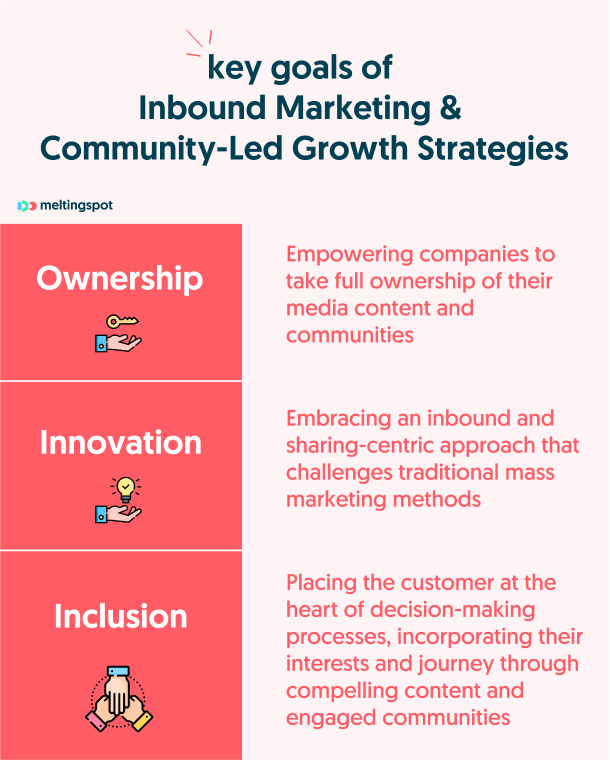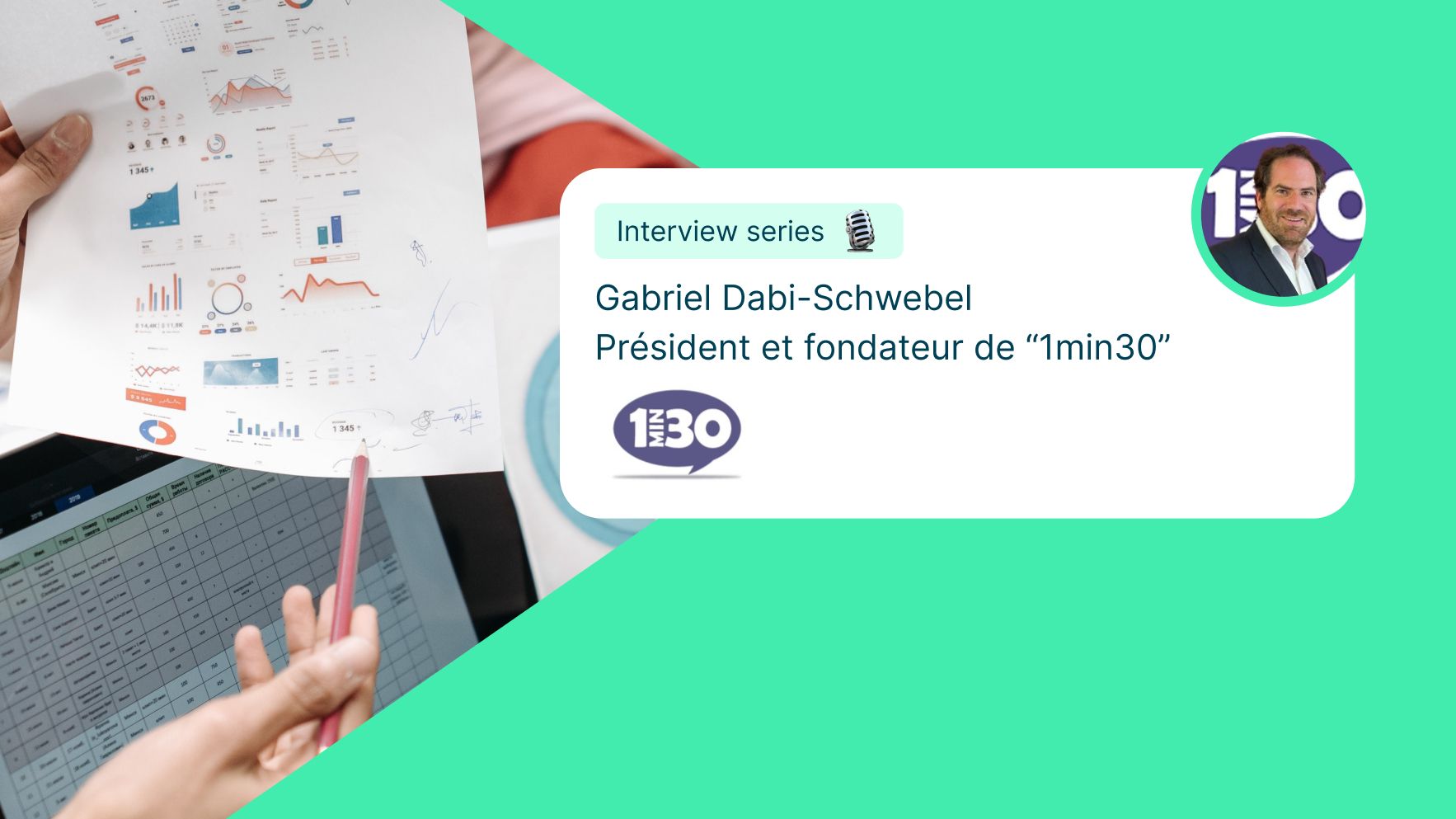"Every company can become its own media: that is the belief of Gabriel Dabi-Schwebel, a pioneer in Inbound Marketing in France and founder of the agency 1min30."
Today, businesses no longer require permission or authorization from major media outlets to create compelling and relevant content.
The concept of ownership is gaining significance in both content marketing and community marketing strategies. Just like in Inbound Marketing, brands no longer need to depend on third-party platforms to cultivate their communities.
We are now witnessing the emergence of two interconnected paradigms: both B2B and B2C companies have the power to establish themselves as proprietors of their own media and communities. This transformation is made possible through the amalgamation of Inbound Marketing and Community-Led Growth.
Let's delve deeper into these evolving dynamics as we explore the insights of Gabriel Dabi-Schwebel (1min30), who was interviewed by MeltingSpot. 👇
What is Inbound Marketing?
Inbound Marketing: Definition
According to Gabriel Dabi-Schwebel, founder of the agency 1min30, Inbound Marketing can be summed up in a simple way: "Becoming your own media and converting your audience into customers." It embraces an "inbound" approach to marketing, where the focus is on attracting customers to your brand rather than aggressively reaching out to them through traditional methods.
In contrast to Outbound Marketing, which involves pushing messages out to potential customers, Inbound Marketing relies on a range of strategies. These include creating and sharing highly valuable content such as blogs, newsletters, and interactive webinars. The aim is to build a qualified audience and establish companies as "media brands." This approach is particularly effective in achieving the following objectives:
1️⃣ Converting website visitors into leads.
2️⃣ Converting leads into customers.
3️⃣ Fostering customer loyalty and turning them into brand advocates.
3 Crucial Questions Before Implementing Inbound Marketing
According to Gabriel Dabi-Schwebel, Inbound Marketing is a relevant and high-performing strategy, but it requires careful consideration of certain prerequisites. Before diving into an Inbound approach, it is essential to address the following key questions:
✅ Is the target market widely dispersed? If the market consists of a mere 100 potential customers, a traditional prospecting strategy might prove more effective in swiftly establishing the company's presence.
✅ Does the company's product or service necessitate education and evangelization? Inbound Marketing shines in situations where the sales process is gradual, demanding the creation of strong rapport and lasting relationships.
✅ What is the competitive landscape within which the company operates? Depending on the ease or difficulty of standing out in a competitive market saturated with SEO-focused players or social media giants, it may be prudent to develop a "hybrid" strategy. This could involve blending elements of Outbound Marketing and Inbound Marketing, as well as leveraging both online and offline channels to effectively reach the target audience.
Thus, Inbound Marketing hinges on an indispensable prerequisite: comprehending consumers, their customer journeys, and the underlying motivations that drive their purchasing decisions.
To accomplish this, harnessing collective intelligence becomes an indispensable lever. Furthermore, for a deeper understanding of the stakeholders engaging with the company, it is often beneficial to combine Inbound Marketing with another strategic approach: Community-Led Growth.

What is Community-Led Growth?
Community-Led Growth: Definition
Community-Led Growth is an innovative business strategy that places the community at the heart of its priorities. It harnesses the power of the community to drive and guide the company's growth, resulting in enhanced performance and success.
In today's landscape, Community-Led Growth follows a "Community Centric" approach, shifting away from the traditional "Product Centric" mindset. The key objective of this community-driven marketing strategy is to create, nurture, and actively engage a thriving community for the long term.
Comprised of dedicated and proactive members, the community becomes a powerful source of collective intelligence, continuous improvement, as well as customer acquisition and retention. It serves as a catalyst for the company's growth journey, fostering a sense of belonging and mutual support among its members.
Community-Led Growth: A Universal and Multisector Strategy
With its community-centric approach to driving growth, Community-Led Growth is emerging as an essential strategy for businesses across all sectors, seeking to unite and rally diverse communities.
Indeed, Community-Led Growth is being embraced by both B2B and B2C companies, ranging from startups to large corporations, all aiming to bring together different communities. Here are some notable examples:
💡 Gabriel Dabi-Schwebel's agency, 1min30, has successfully cultivated a community of clients that significantly boosts the company's performance. Through this engaged client community, customer retention rates have soared from 50% to an impressive 90%! Moreover, the agency also fosters a community of consultants, contributing substantial value to clients.
💡 Notion, the collaborative application, serves as a prime illustration of a Community-Led company. In France, the platform has established a vibrant community of French-speaking users who benefit from specialized resources such as guides, tutorials, and training. Additionally, they actively participate in events and engage in real-time discussions with the platform's 2,500 members on Discord. This customer community acts as a valuable source of feedback, guiding Notion's growth.
💡 Komuno, a training provider in the field of Community Building, not only educates clients on creating communities but also cultivates its own community of Community Builders. Komuno has fostered a close-knit group of "mentees" who benefit from curated content, cross-collaboration opportunities, and engaging events.
Thus, there exist various models of internal and external communities, each tailored to specific objectives. Their common thread lies in uniting dedicated members who steer company growth through the principles of Community-Led Growth.
But does one necessarily have to choose between Inbound Marketing and Community-Led Growth when structuring their company's strategy?
Inbound Marketing and Community-Led Growth: Synergistic Strategies for Success
Inbound Marketing and Community-Led Growth: Shared Objectives
MeltingSpot (a leading platform in Community-Led Growth) and 1min30 (a renowned agency specializing in Inbound Marketing) share a common vision: these two strategies complement each other in driving the growth and performance of businesses.
Both Inbound Marketing and Community-Led Growth align on key goals of ownership, innovation, and inclusion:

Harnessing Collective Intelligence: A Shared Trait of Inbound Marketing and Community-Led Growth
Inbound Marketing and Community-Led Growth both embrace a shift from the "Do-It-Yourself" approach to the more collaborative "Do-It-Together" mindset. At the heart of these models lies the power of collective intelligence, sharing, and co-creation.
In the realm of Inbound Marketing, businesses bring together diverse teams, such as sales and marketing, to craft the most effective strategies. Furthermore, involving customers in the process helps transition from a top-down communication style to a collaborative bottom-up approach. For instance, 1min30 hosts interactive webinars where participants actively contribute and co-create real-time content.
This "Do-It-Together" ethos permeates Community-Led Growth strategies as well. Both B2B Communities and B2C communities thrive on co-creation, collective intelligence, and horizontal sharing. By fostering strong collaboration between companies and their community members, growth becomes guided by the collective wisdom of the community.
Moreover, these two strategies can seamlessly integrate with each other. Inbound Marketing serves as a catalyst for community engagement, delivering valuable content that resonates with members. In a Community-Led Growth strategy, Inbound Marketing often serves as a linchpin for success, as engaging content plays a pivotal role in fostering a cohesive and thriving community.
Are you prepared to elevate your strategies with Community-Led Growth and Inbound Marketing?
It's clear: the strategies of Inbound Marketing and Community-Led Growth are not only complementary but also mutually enriching. It's not uncommon to see companies developing a community-driven marketing approach that leverages Inbound Marketing.
In closing, Gabriel Dabi-Schwebel emphasizes the significance of ownership in driving business growth:
💬 "The power of a community lies in its ever-increasing value. However, to achieve this, it's essential to be the owner of your community. Relying on platforms like Facebook or LinkedIn for Community-Led Growth is highly risky. We need to create our communities on platforms that allow us to retain ownership, where we can nurture and deliver value... and avoid being trapped in an algorithm that diminishes our reach." - Gabriel Dabi-Schwebel, founder of 1min30 agency.
Does this conviction resonate with you? At MeltingSpot, we have made it our mission. Discover our community platform by clicking here 👇

Become a Digital Customer Success Champion with MeltingSpot Academy!
Step into MeltingSpot Academy, your ultimate training hub for mastering Digital Customer Success. Level up your skills and become an expert in customer onboarding and education. Join a community of passionate CS leaders who are mastering the latest tools and strategies, including MeltingSpot and other top solutions. Get access to exclusive courses, masterclasses, inspiring talks, eBooks, and more to boost your expertise and lead the way!
Join Academy






